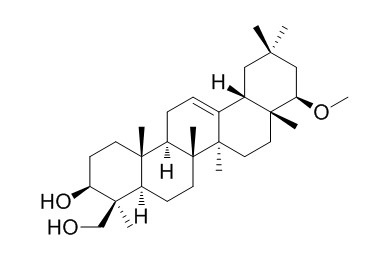Soyasapogenol D
Reference standards.
Inquire / Order:
manager@chemfaces.com
Technical Inquiries:
service@chemfaces.com
Tel:
+86-27-84237783
Fax:
+86-27-84254680
Address:
1 Building, No. 83, CheCheng Rd., Wuhan Economic and Technological Development Zone, Wuhan, Hubei 430056, PRC
Providing storage is as stated on the product vial and the vial is kept tightly sealed, the product can be stored for up to
24 months(2-8C).
Wherever possible, you should prepare and use solutions on the same day. However, if you need to make up stock solutions in advance, we recommend that you store the solution as aliquots in tightly sealed vials at -20C. Generally, these will be useable for up to two weeks. Before use, and prior to opening the vial we recommend that you allow your product to equilibrate to room temperature for at least 1 hour.
Need more advice on solubility, usage and handling? Please email to: service@chemfaces.com
The packaging of the product may have turned upside down during transportation, resulting in the natural compounds adhering to the neck or cap of the vial. take the vial out of its packaging and gently shake to let the compounds fall to the bottom of the vial. for liquid products, centrifuge at 200-500 RPM to gather the liquid at the bottom of the vial. try to avoid loss or contamination during handling.
Antioxidants (Basel).2020, 9(7):581.
Phytomedicine.2023, 120:155063.
Biochem Systematics and Ecology2017, 11-18
Antioxidants.2022, 11(3):491.
Molecules.2021, 26(12):3652.
Br J Pharmacol.2018, 175(6):902-923
Pharmaceutics.2021, 13(11):1839.
Toxins (Basel).2020, 12(4):210.
Journal of Cluster Science2024, 35:635-656.
Theoretical and Experimental Plant Physiology 2022, 34,53-62
Related and Featured Products
J Chromatogr, 1971, 56(2):281-293.
Ion-exchange chromatography of soybean saponins1[Reference:
WebLink]
METHODS AND RESULTS:
Resolution of soybean saponins on Dowex-1 is influenced by resin particle size, flow rate, temperature and eluting agent. Separations were good when columns of −400 mesh resin were operated at 50° and eluted at slow flow rates either acetic or propionic acid. A linear gradient of 1.5 to 3 N propionic acid separated the saponins into twelve fractions, many of which consisted of two or more components when analyzed by thin-layer chromatography. Glucuronic acid, glucose, galactose rhamnose, xylose and arabinose were found in acid hydrolyzates of all fractions, but relative amounts of the neutral sugars varied in most fractions.
CONCLUSIONS:
On analysis of the aglycones, three column fractions contained only soyasapogenol A, one contained only soyasapogenol E, while four consisted of soyasapogenol B plus small amounts of soyasapogenols C and D. Another fracion yielded a previously unreported aglycone which appears related to Soyasapogenol D.



